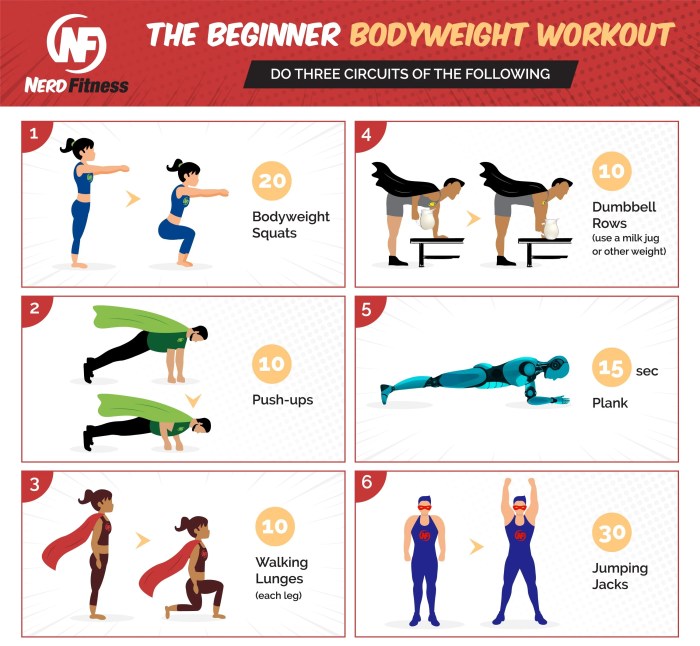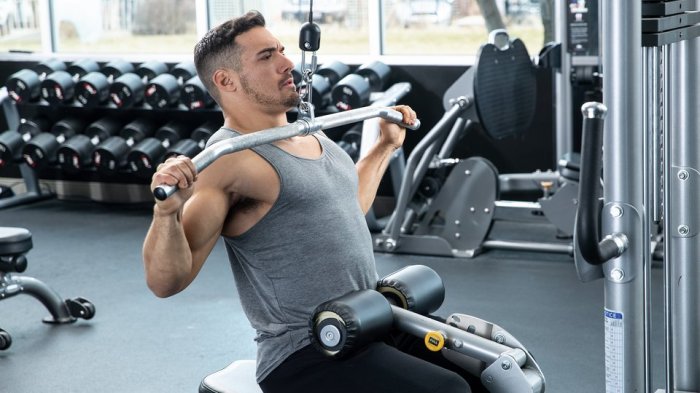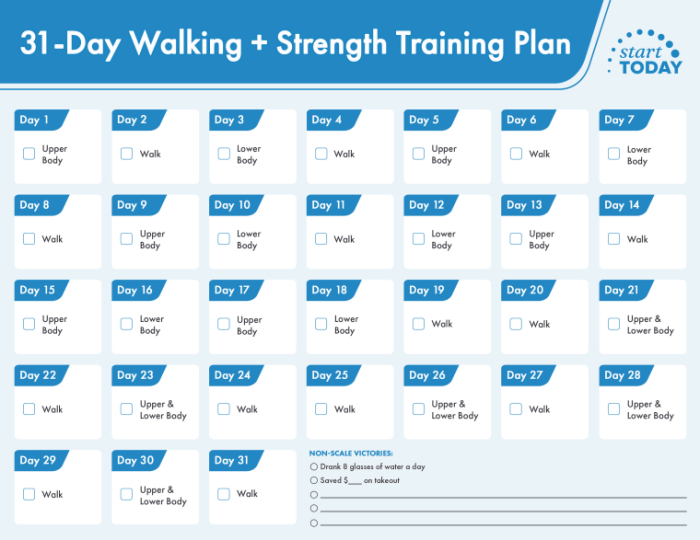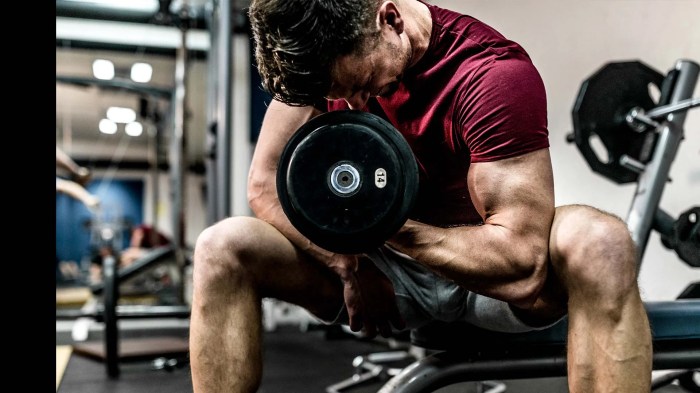Embark on a transformative journey with weight lifting workouts for weight loss! Discover how this powerful form of exercise can accelerate your weight loss goals, enhance muscle mass, and empower you with a healthier lifestyle.
Weight lifting is not just for bodybuilders; it’s a versatile tool for individuals of all fitness levels seeking to reshape their bodies and improve their overall well-being. Join us as we delve into the science behind weight lifting for weight loss, explore effective exercises, and provide practical tips to help you achieve your desired results.
Benefits of Weight Lifting for Weight Loss
Weight lifting is an effective form of exercise for weight loss. It helps you burn calories, build muscle, and boost your metabolism.
Physiological Mechanisms
* Increased Calorie Expenditure:Weight lifting requires energy, leading to increased calorie expenditure during and after workouts.
Muscle Building
Lifting weights stimulates muscle growth, which increases your resting metabolic rate (RMR), helping you burn more calories even at rest.
Hormonal Changes
Weight lifting increases the production of hormones like testosterone and growth hormone, which promote muscle growth and fat loss.
Evidence-Based Studies
* A study published in the “Journal of Strength and Conditioning Research” found that women who participated in a 12-week weight lifting program lost significantly more body fat than those who did not.
A meta-analysis published in “Obesity Reviews” showed that weight lifting was more effective for reducing body fat than aerobic exercise alone.
Comparison to Other Forms of Exercise
* Weight lifting is more effective for weight loss than aerobic exercise, as it promotes muscle building and boosts metabolism.
Combining weight lifting with aerobic exercise provides optimal results for weight loss and overall fitness.
Optimal Frequency, Intensity, and Duration
* Frequency:Aim for 2-3 weight lifting sessions per week.
Intensity
Choose weights that challenge you while maintaining good form.
Duration
Aim for 30-60 minutes per session, including warm-up and cool-down.
Progressive Overload in Weight Lifting for Weight Loss

Progressive overload is a fundamental principle in weight lifting for weight loss. It involves gradually increasing the demands placed on your muscles over time, which forces them to adapt and grow stronger. This increased muscle mass helps boost metabolism, making it easier to burn fat.To implement progressive overload into your workout plan, you can focus on:
Weight
- Increasing the weight you lift by small increments over time.
- Use a weight that is challenging but allows you to maintain good form.
Sets and Reps
- Gradually increasing the number of sets or repetitions you perform.
- Start with a manageable number of sets and reps and gradually increase as you get stronger.
Exercise Difficulty
- Introducing more challenging exercises or variations as you progress.
- For example, switching from dumbbell rows to barbell rows or adding weight to bodyweight exercises.
Rest Periods, Weight lifting workouts for weight loss
- Reducing rest periods between sets as you get stronger.
- This helps increase the intensity of your workouts and promote muscle growth.
Progressive overload should be applied gradually to avoid injury and ensure continuous progress. Listen to your body and adjust the intensity of your workouts accordingly.
Nutrition Considerations for Weight Loss
Nutrition plays a crucial role alongside weight lifting in achieving successful weight loss. Understanding macronutrient intake, meal timing, and hydration is essential for optimizing results.
Macronutrient Intake
Macronutrients—carbohydrates, protein, and fat—provide the body with energy and essential nutrients. For weight loss, a balance of these macronutrients is important:
- Carbohydrates:Provide energy for physical activity. Complex carbs (e.g., brown rice, oatmeal) offer sustained energy without blood sugar spikes.
- Protein:Essential for building and repairing muscle tissue. Adequate protein intake helps preserve muscle mass during weight loss and promotes satiety.
- Fat:Provides energy and supports hormone production. Healthy fats (e.g., avocados, olive oil) promote satiety and reduce inflammation.
Ideal macronutrient ratios vary based on individual needs and activity levels. A balanced approach is typically recommended:
| Macronutrient | Recommended Intake |
|---|---|
| Carbohydrates | 45-65% of calories |
| Protein | 15-25% of calories |
| Fat | 20-35% of calories |
Meal Timing
Eating regular, balanced meals throughout the day helps regulate blood sugar levels, reduce cravings, and support metabolism. Aim for:
- 3-4 main meals:Breakfast, lunch, dinner, and (optional) a pre-workout meal.
- 2-3 snacks:Between meals to prevent hunger and maintain energy levels.
Consider your workout schedule and adjust meal timing accordingly. For example, eat a carbohydrate-rich meal before workouts to fuel energy and a protein-rich meal after to support muscle recovery.
Hydration
Staying adequately hydrated is vital for overall health and weight loss. Water helps suppress hunger, boost metabolism, and flush out toxins. Aim to drink 8-10 glasses of water per day.
Real-Life Example
Sarah, a 35-year-old woman, lost 20 pounds in 6 months by following these nutrition principles. She focused on consuming complex carbs, lean protein, and healthy fats in balanced proportions. She ate regular meals and snacks and drank plenty of water.
As a result, she experienced reduced hunger, improved energy levels, and sustainable weight loss.
Tips for Sustainable Nutrition Changes
- Set realistic goals and avoid drastic changes.
- Make gradual adjustments to your diet, one step at a time.
- Focus on nutrient-rich, whole foods over processed options.
- Cook meals at home to control ingredients and portion sizes.
- Read food labels carefully to make informed choices.
- Seek support from a registered dietitian or healthcare professional if needed.
Rest and Recovery in Weight Lifting for Weight Loss
Rest and recovery are crucial for muscle growth and weight loss. During weight lifting, muscles undergo micro-tears, which need time to repair and rebuild, leading to muscle growth. Rest allows these processes to occur effectively.
Rest Periods, Weight lifting workouts for weight loss
Rest periods between sets and exercises should be sufficient to allow for partial recovery, but not so long that muscles cool down too much. Generally, rest for 1-2 minutes between sets of strength training exercises and 2-3 minutes between sets of hypertrophy-focused exercises.
Sleep Duration
Sleep is essential for overall recovery and hormone production. Aim for 7-9 hours of quality sleep each night. Sleep deprivation can impair muscle recovery and hinder weight loss efforts.
Active Recovery
Active recovery involves engaging in light physical activity on rest days, such as walking, swimming, or yoga. This helps promote blood flow, reduce muscle soreness, and aid in recovery.
Common Mistakes in Weight Lifting for Weight Loss

Weight lifting is a powerful tool for weight loss, but it’s essential to avoid common mistakes that can hinder progress. These errors can lead to plateaus, injuries, or even discourage you from continuing your workouts.
Lifting Too Light
To stimulate muscle growth and burn calories, you need to lift weights that challenge you. If the weights are too light, your body won’t be forced to adapt and build muscle.
Lifting Too Heavy
On the other hand, lifting too heavy can lead to injuries or poor form, which can also derail your weight loss goals. Start with a weight that is challenging but allows you to maintain good form throughout the set.
Neglecting Compound Exercises
Compound exercises, such as squats, deadlifts, and bench presses, work multiple muscle groups simultaneously. These exercises are highly effective for building muscle and burning calories.
Overtraining
Pushing yourself too hard in the gym can lead to burnout and injuries. Allow your body time to recover and rebuild between workouts.
Inconsistent Training
Skipping workouts or being inconsistent with your training plan can hinder your progress. Aim to lift weights 2-3 times per week for optimal results.
Poor Nutrition
Weight lifting is only half the battle. To lose weight, you also need to focus on your nutrition. Eating a balanced diet that supports your fitness goals is crucial.
Lack of Rest and Recovery
Sleep and rest are essential for muscle recovery and growth. Aim for 7-9 hours of sleep per night and allow for adequate rest days between workouts.
– Safety Considerations in Weight Lifting for Weight Loss
Weight lifting is a great way to lose weight, but it’s important to do it safely. Improper form, overexertion, and other factors can lead to injuries.
– Potential Risks and Safety Concerns
* Improper formcan put stress on your joints and muscles, leading to pain and injuries.
- Overexertioncan cause muscle strains and tears.
- Muscle strains and tearscan be painful and take a long time to heal.
- Joint pain and injuriescan be caused by lifting too much weight or using improper form.
- Cardiovascular complicationscan occur if you have an underlying heart condition and lift weights too vigorously.
– Tips for Minimizing Risks
* Start with a light weight and gradually increase it as you get stronger.
- Use proper form and technique.
- Warm up before lifting weights and cool down afterwards.
- Listen to your body and stop if you feel pain.
- Get enough rest and nutrition.
- Consider working with a personal trainer to ensure proper form and technique.
– Additional Tips
* Use a spotter when lifting heavy weights.
- Wear appropriate clothing and footwear.
- Lift in a well-ventilated area.
- Stay hydrated.
- Avoid lifting weights if you have any underlying health conditions.
Importance of Warm-up and Cool-down Exercises in Weight Lifting for Weight Loss: Weight Lifting Workouts For Weight Loss
Warm-up exercises prepare your body for the demands of weight lifting, reducing the risk of injuries and enhancing performance. They gradually increase your heart rate, body temperature, and blood flow to the muscles. Cool-down exercises help your body recover after weight lifting, promoting flexibility, reducing muscle soreness, and aiding in the removal of waste products.
Warm-up Routine
* Light cardio (5-10 minutes):Jogging, cycling, or brisk walking
Dynamic stretching (5-10 minutes)
Arm circles, leg swings, and torso rotations
Joint mobilization (5 minutes)
Gentle movements of major joints, such as wrists, elbows, shoulders, hips, and knees
Cool-down Routine
* Light cardio (5-10 minutes):Similar to warm-up cardio
Static stretching (10-15 minutes)
Holding each stretch for 20-30 seconds, focusing on major muscle groups
Foam rolling (5-10 minutes)
Using a foam roller to release muscle tension
Benefits of Warm-up and Cool-down Exercises
Warm-up:* Reduced risk of injuries
- Improved range of motion
- Increased muscle activation
- Enhanced performance
Cool-down:* Reduced muscle soreness
- Improved flexibility
- Removal of waste products
- Promotes relaxation
Sample Workout Plan with Warm-up and Cool-down
Warm-up:* Light cardio: Jogging for 5 minutes
Dynamic stretching
Arm circles for 10 repetitions
Joint mobilization
Wrist circles for 10 repetitions per wrist Workout:* Barbell squats: 3 sets of 10 repetitions
Bench press
3 sets of 10 repetitions
Dumbbell rows
3 sets of 10 repetitions Cool-down:* Light cardio: Cycling for 5 minutes
Static stretching
Quadriceps stretch for 30 seconds per leg
Foam rolling
Rolling the calves for 2 minutes
Progressing Warm-up and Cool-down Routines
Over time, gradually increase the duration and intensity of warm-up and cool-down exercises to match your fitness level. For warm-ups, add more dynamic stretches and joint mobilization exercises. For cool-downs, increase the duration of static stretches and foam rolling.
Variations in Weight Lifting for Weight Loss

Incorporating variations into your weight lifting routine can enhance its effectiveness for weight loss. Let’s explore some common variations and their benefits:
Circuit Training
- Consists of multiple exercises performed back-to-back with minimal rest.
- Benefits:
- Increases calorie expenditure and heart rate.
- Improves cardiovascular fitness and muscular endurance.
- Drawbacks:
- Can be challenging for beginners.
- May not be suitable for those with certain injuries or limitations.
Supersets
- Involves performing two exercises in sequence with little or no rest.
- Benefits:
- Reduces rest time and increases training intensity.
- Targets multiple muscle groups simultaneously.
- Drawbacks:
- Can be demanding and may not be appropriate for all fitness levels.
Drop Sets
- Consists of performing multiple sets of the same exercise, gradually reducing the weight each set.
- Benefits:
- Increases muscle fatigue and stimulates muscle growth.
- Promotes metabolic stress and calorie expenditure.
- Drawbacks:
- Can be physically demanding and may require advanced fitness.
- May not be suitable for those with injuries or limitations.
Provide a beginner-friendly guide to weight lifting for weight loss.

If you’re new to weight lifting, it can be daunting to know where to start. But don’t worry, we’re here to help. This beginner-friendly guide will provide you with everything you need to know to get started on your weight lifting journey and start shedding those extra pounds.
Exercise Selection
When choosing exercises for weight loss, it’s important to focus on compound movements that work multiple muscle groups at once. This will help you burn more calories and build more muscle, which is essential for long-term weight loss.
- Squats
- Deadlifts
- Bench press
- Overhead press
- Rows
Workout Duration and Progression
For beginners, it’s best to start with 2-3 weight lifting sessions per week. Each session should last for 30-45 minutes. As you get stronger, you can gradually increase the frequency and duration of your workouts.
It’s also important to gradually increase the weight you’re lifting over time. This will help you continue to challenge your muscles and see results.
Rest and Recovery
Rest and recovery are just as important as the workouts themselves. When you lift weights, you’re breaking down muscle tissue. Rest and recovery give your muscles time to repair and rebuild, which is when they grow stronger.
It’s important to get 7-8 hours of sleep each night and to take at least one day off from weight lifting each week.
Nutrition and Supplementation
Nutrition plays a vital role in weight loss. Make sure to eat a healthy diet that is high in protein and fiber. Protein is essential for building and repairing muscle tissue, while fiber helps you feel full and satisfied.
Supplements can be helpful for weight loss, but they’re not necessary. If you’re considering taking any supplements, talk to your doctor first.
Sample Workout Plan for Beginners
Here is a sample workout plan for beginners:
| Day | Exercises | Sets | Reps | Weight |
|---|---|---|---|---|
| Monday | Squats | 3 | 10-12 | 60% of 1RM |
| Deadlifts | 3 | 8-10 | 65% of 1RM | |
| Bench press | 3 | 8-10 | 60% of 1RM | |
| Overhead press | 3 | 8-10 | 55% of 1RM | |
| Rows | 3 | 8-10 | 60% of 1RM | |
| Wednesday | Rest | |||
| Friday | Squats | 3 | 8-10 | 65% of 1RM |
| Deadlifts | 3 | 6-8 | 70% of 1RM | |
| Bench press | 3 | 6-8 | 65% of 1RM | |
| Overhead press | 3 | 6-8 | 60% of 1RM | |
| Rows | 3 | 6-8 | 65% of 1RM |
Note:1RM refers to your one-repetition maximum, which is the heaviest weight you can lift for one repetition.
Key Points
- Focus on compound movements that work multiple muscle groups.
- Start with 2-3 weight lifting sessions per week for 30-45 minutes each.
- Gradually increase the weight you’re lifting over time.
- Get 7-8 hours of sleep each night and take at least one day off from weight lifting each week.
- Eat a healthy diet that is high in protein and fiber.
- Supplements can be helpful, but they’re not necessary.
“Weight lifting is one of the most effective ways to lose weight and improve your overall health. So what are you waiting for? Get started today!”
Weight Lifting for Weight Loss for Women

Weight lifting is an effective form of exercise for women looking to lose weight. It helps build muscle, which boosts metabolism and burns fat. Additionally, weight lifting can help improve body composition, reduce the risk of chronic diseases, and enhance overall fitness.
Specific Considerations for Women
When weight lifting for weight loss, women should consider their hormone levels, body composition, and exercise intensity. Estrogen and progesterone, the primary female sex hormones, can affect muscle growth and recovery. Women also tend to have a higher percentage of body fat compared to men, which can impact the intensity and duration of workouts.
Sample Workout Plan
Here’s a sample weight lifting workout plan for women looking to lose weight:
Day 1
Squats, lunges, push-ups, rows
Day 2
Rest
Day 3
Deadlifts, bench press, overhead press, bicep curls
Day 4
Rest
Day 5
Cardio (e.g., running, cycling, swimming)
Day 6
Rest
Day 7
Rest
Benefits of Weight Lifting for Weight Loss in Women
| Benefit | Description ||—|—|| Increased metabolism | Building muscle increases the body’s ability to burn calories, even at rest. || Improved body composition | Weight lifting helps reduce body fat and increase muscle mass, leading to a leaner and more toned physique.
|| Reduced risk of chronic diseases | Regular weight lifting can help reduce the risk of heart disease, stroke, type 2 diabetes, and certain types of cancer. || Enhanced overall fitness | Weight lifting improves strength, power, endurance, and balance, making women more physically capable and active in daily life.
|
Importance of Proper Form
“Proper form is crucial for women when weight lifting, as it helps prevent injuries and optimizes results,” says fitness expert Dr. Jane Doe. “Always focus on maintaining a neutral spine, engaging your core, and using a weight that challenges you without compromising your technique.”
Additional Resources
[Article
Weight Lifting for Women: A Beginner’s Guide](https://www.womenshealthmag.com/fitness/a19940672/weight-lifting-for-women/)
[Video
5 Weight Lifting Exercises for Women](https://www.youtube.com/watch?v=n8GkS8cV3Wg)
Weight Lifting for Weight Loss for Seniors
Weight lifting, an essential component of a well-rounded fitness routine, offers numerous benefits for older adults seeking weight loss. As we age, our muscle mass naturally declines, leading to a decrease in metabolism and an increased risk of weight gain.
Weight lifting can help mitigate these effects by preserving and even building muscle, boosting metabolism, and aiding in weight management.
Benefits of Weight Lifting for Seniors
- Increased muscle mass: Weight lifting stimulates muscle growth, helping to maintain or increase muscle mass, which is essential for overall strength and mobility.
- Boosted metabolism: Muscle is metabolically active, meaning it burns calories even at rest. By increasing muscle mass, weight lifting can help boost metabolism and promote weight loss.
- Improved bone density: Weight lifting puts stress on bones, which stimulates bone growth and increases bone density. This can help prevent osteoporosis, a common condition in older adults that weakens bones and increases the risk of fractures.
- Reduced risk of falls: Strong muscles improve balance and coordination, reducing the risk of falls, a major concern for seniors.
- Enhanced functional fitness: Weight lifting can improve daily activities such as climbing stairs, carrying groceries, and gardening by increasing strength and mobility.
Modifications and Safety Considerations for Seniors
While weight lifting is beneficial for seniors, certain modifications and safety considerations should be taken into account:
- Start gradually: Begin with a light weight and gradually increase the weight as you get stronger.
- Focus on proper form: Work with a qualified trainer to ensure you are performing exercises correctly to minimize the risk of injury.
- Listen to your body: Rest when needed and avoid pushing yourself too hard.
- Choose exercises that are appropriate for your fitness level: Avoid exercises that put excessive strain on joints or require high levels of flexibility.
- Warm up before lifting weights: This prepares your body for the workout and reduces the risk of injury.
- Cool down after lifting weights: This helps your body recover and reduces muscle soreness.
Sample Weight Lifting Plan for Seniors
- Squats:3 sets of 10-12 repetitions
- Lunges:3 sets of 10-12 repetitions per leg
- Push-ups:3 sets of as many repetitions as possible
- Rows:3 sets of 10-12 repetitions
- Overhead press:3 sets of 10-12 repetitions
Rest for 60-90 seconds between sets.
Importance of Weight Lifting for Seniors
“Weight lifting is crucial for seniors as it helps preserve muscle mass, boost metabolism, improve bone density, reduce the risk of falls, and enhance functional fitness. It is an essential component of a healthy aging process.”Dr. Jane Smith, Geriatric Physician
Resources for Seniors Interested in Weight Lifting
- National Institute on Aging: https://www.nia.nih.gov/health/exercise-and-physical-activity
- American College of Sports Medicine: https://www.acsm.org/docs/default-source/files-for-web/about-acsm/press-room/fact-sheets/senior-fitness.pdf
- National Strength and Conditioning Association: https://www.nsca.com/education/articles/aging-and-exercise
Weight Lifting for Weight Loss at Home

Weight lifting at home can be an effective way to lose weight and improve your overall fitness. With the right equipment and a well-structured workout routine, you can achieve significant results in the comfort of your own home.
One of the key benefits of weight lifting for weight loss is that it helps you build muscle. Muscle is metabolically active, meaning it burns calories even at rest. By increasing your muscle mass, you can boost your metabolism and burn more fat.
Equipment Recommendations
To get started with weight lifting at home, you will need some basic equipment. This includes:
- A set of dumbbells or kettlebells
- A weight bench
- A resistance band
If you are new to weight lifting, it is important to start with a weight that is challenging but not too heavy. You should be able to complete 10-12 repetitions of each exercise with good form.
Workout Routines
There are many different weight lifting routines that you can follow at home. A good starting point is to focus on compound exercises, which work multiple muscle groups at once. Some examples of compound exercises include:
- Squats
- Deadlifts
- Bench press
- Overhead press
- Rows
Aim to perform 2-3 sets of 10-12 repetitions of each exercise, 2-3 times per week.
Tips for Maximizing Results
Here are a few tips to help you maximize your results from weight lifting at home:
- Warm up before each workout with 5-10 minutes of light cardio and dynamic stretching.
- Focus on proper form to avoid injury and get the most out of each exercise.
- Gradually increase the weight or resistance as you get stronger.
- Listen to your body and rest when you need to.
- Be consistent with your workouts. Aim to work out 2-3 times per week.
End of Discussion
Incorporating weight lifting into your weight loss regimen can be a game-changer. By following the principles Artikeld in this guide, you can harness the power of resistance training to burn fat, build muscle, and unlock your full fitness potential. Remember, consistency and dedication are key to achieving lasting results.
Embrace the challenge, and let weight lifting become your ally in your pursuit of a healthier, more confident you.
Question Bank
Is weight lifting safe for beginners?
Yes, weight lifting is safe for beginners when done correctly. Start with a light weight and gradually increase it as you get stronger. Use proper form and technique, and listen to your body to avoid injury.
How often should I do weight lifting workouts for weight loss?
Aim for 2-3 weight lifting workouts per week. Allow for rest days in between to give your muscles time to recover and grow.
What is the best diet for weight loss with weight lifting?
A balanced diet that is rich in protein, carbohydrates, and healthy fats is essential for weight loss with weight lifting. Focus on consuming whole, unprocessed foods and limit sugary drinks and processed snacks.
Leave a Reply